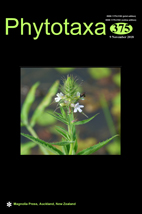Abstract
Forest remnants of La Carbonería are the last patches of natural vegetation near the city of Ibarra. These forest patches are now isolated and restricted to areas of rugged topography and sustain a scarcely explored, largely unknown flora. As an example of this, two new species of orchids were discovered in our first exploration: Lepanthes ibarrae and Lepanthes obandoi, which are described and illustrated in this article. Lepanthes ibarrae is similar to L. zapatae , but is distinguished by its arched stems, reduced petals with a small, rounded apicule, lip with lanceolate-oblong, papillose laminae, small, rounded appendix covered with white pubescence at apex and the triangular, long-attenuate, reflexed rostelum. Lepanthes obandoi is reminiscent of L. muscula, L. guanacasensisr & R. Escobar and L. osiris, but can be distinguished by the much taller plant with distinct superposed stems, elongate appendix with orbicular, pubescent apex and a prominent tuft of white hairs at the base.

